|
Lake Nakuru and Lake Elmenteita, Kenya July 2000 |
||
| (Click any photo throughout to see a larger version) | ||

|
||

|
||
| Bird Land | ||
| Lake Nakuru, in the heart of East Africa's Great Rift Valley, is home to more than a third of the world's population of flamingos. As many as two million can be seen at once foraging in the muck of this small, shallow, soda lake. Perhaps 1 out of every 50 is a greater flamingo (Phoenicopterus roseus), with the vast majority being lesser flamingos (Phoeniconaias minor). | ||
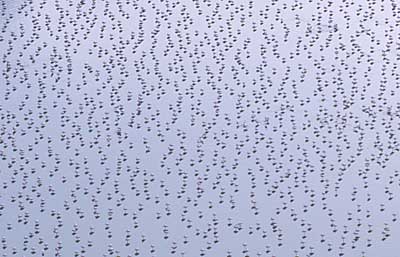
|
||
| Flamingos at Dusk | ||
| We spent two nights staying at Delamere's Camp on the shore of nearby Lake Elmenteita. Lake Elmenteita is very small, much smaller even than Lake Nakuru, but has its own mob of flamingos. This photograph was taken just as the sun was setting, from atop a nearby cliff. | ||
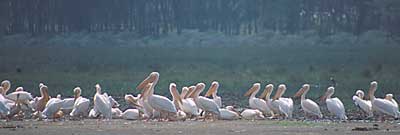
|
||
| Not Just Flamingos | ||
| Lake Nakuru provides habitat for scads of hydrophilic birds other than flamingos also. Here's a troop of white pelicans. We also saw cormorants, ducks, geese, storks, spoonbills, and egrets of all shapes and sizes. | ||
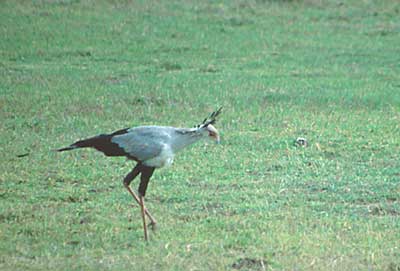
|
||
| Politically Incorrect | ||
| Here's a secretary bird in full regalia prowling the lakeshore for snakes. Secretary birds were my favorite birds from our whole Africa trip. They're big and colorful, with a ridiculous headdress, and it's hard to avoid laughing when you see them strutting about. The snakes aren't laughing though. Nowadays we might have to call them "administrative assistant birds". | ||
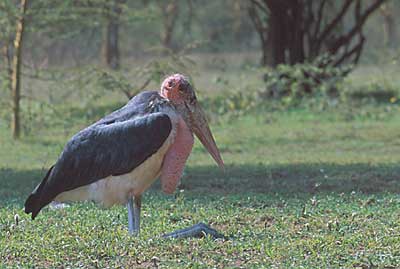
|
||
| Ouch | ||
| Marabou storks are common throughout East Africa. They are as at home scrounging through human trash heaps as are gulls and ravens in the United States, and they are also doing well in the wilder areas. They are not blessed with great beauty. And just thinking about bending my knees that way hurts. | ||
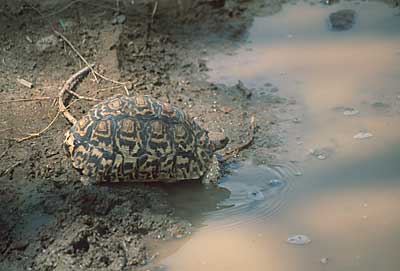
|
||
| Thirsty Tortoise | ||
| This beautifully patterned leopard tortoise had stopped in the middle of the dirt car track to have itself a drink. As we discovered on our trip, spotting wild tortoises is approximately 1000 times harder than spotting, say, wild antelope. | ||
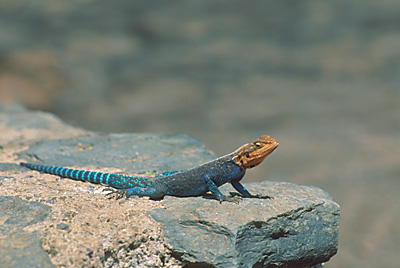
|
||
| Rainbow Lizard | ||
| High atop a rocky outcropping that overlooks Lake Nakuru, a band of common agamas thrived, with this dominant male ruling the roost. I think the tortoise and agama were battling it out for the title of Lake Nakuru's Most Beautiful Reptile. | ||
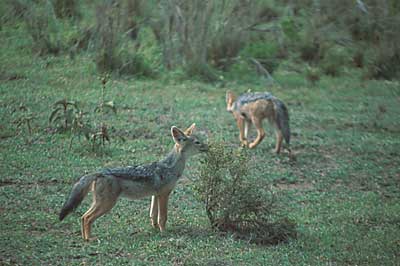
|
||
| Cute Little Puppies | ||
| Lake Nakuru National Park, a fairly narrow band of land encircling the lake, is not without its fair share of warm-blooded wildlife. These two are black-backed jackal pups. | ||
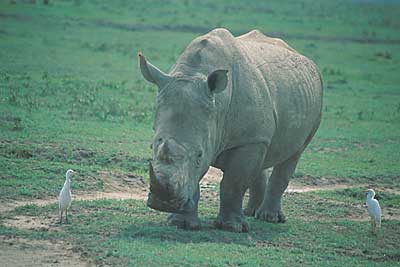
|
||
| Daddy Rhino | ||
| Our guide Albanus spotted this adult male white rhinoceros from far across a plain, and drove to the spot where he predicted the rhino would cross the car track. Sure enough, thirty minutes later we had a close personal encounter as the rhino crossed within 20 feet of our car. The two egrets were at his heels the entire time we were watching, eagerly snatching at grasshoppers and other critters disturbed by the thundering footsteps of big daddy here. | ||
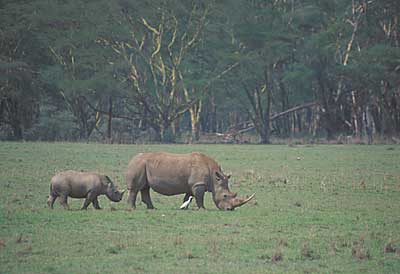
|
||
| Momma and Baby Rhino | ||
| Not too far behind the male were this female and young white rhinoceros (accompanied once again by their own personal egret). Lake Nakuru is one of the few homes of both white (a.k.a. graze) and black (a.k.a. browse) rhinoceros. The white rhinoceros is very rare, but still much more common than the critically endangered black rhinoceros. | ||
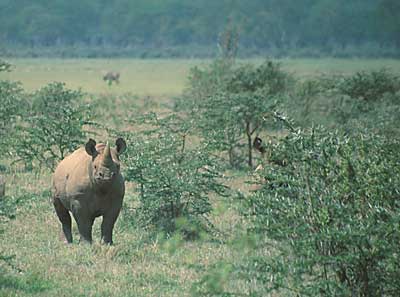
|
||
| Why Isn't This Rhino Black? | ||
| We lucked upon a pair of black rhinoceros also (one is mostly hidden behind bushes on the right). They took one look at us and dashed away, unlike the white rhinos that had strolled by apparently oblivious to our presence. Note that the "white" and "black" rhinoceros are actually indistinguishable in color. The most noticeable difference is in size and the shape of the lips: the white rhino's lips are wide, adapted for grazing grasses; the black rhino's lips are pointed, adapted for grasping and browsing from bushes. The oft-repeated story of the name origin is that Dutch settlers saw the grazing rhino and called it "weit", meaning "wide", and referring to the shape of its lips. Later this became "white" due to language confusion. This story doesn't explain why the browsing rhino is called "black", but I assume that was just to distinguish it from "white". | ||
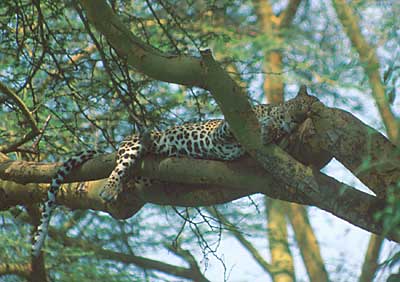
|
||
| Cat Nap | ||
| Lake Nakuru is home to leopard tortoises and leopard cats both. This gorgeous animal was napping away the warm afternoon hours in a yellow acacia tree. | ||
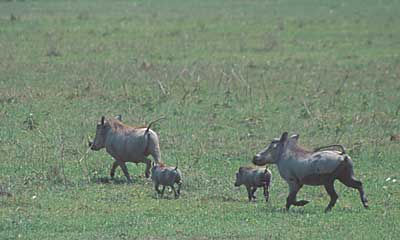
|
||
| The Kenya Express | ||
| Warthogs startle easily, and when they are startled they run away with their little stiff warthog tails waving about like car radio antennae in a windstorm. Albanus liked to call this the Kenya Express. With their big curved tusks they might appear rather fierce, but you wouldn't think that after seeing them constantly running away. | ||
Onward to Masai Mara Game Reserve | ||
| Return to Uganda and Kenya Trip Overview | ||